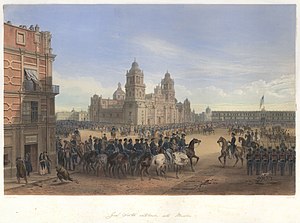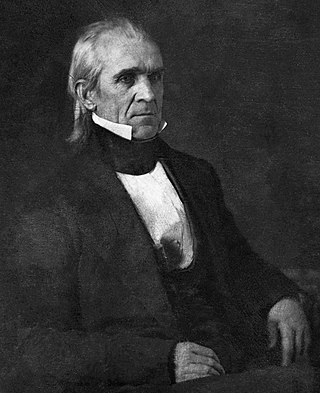
James Knox Polk was the 11th president of the United States, serving from 1845 to 1849. He also served as the 13th speaker of the House of Representatives from 1835 to 1839 and the ninth governor of Tennessee from 1839 to 1841. A protégé of Andrew Jackson, he was a member of the Democratic Party and an advocate of Jacksonian democracy. Polk is known for extending the territory of the United States through the Mexican–American War during his presidency, annexing the Republic of Texas, the Oregon Territory, and the Mexican Cession after winning the Mexican–American War.

The 1840s was a decade of the Gregorian calendar that began on January 1, 1840, and ended on December 31, 1849.
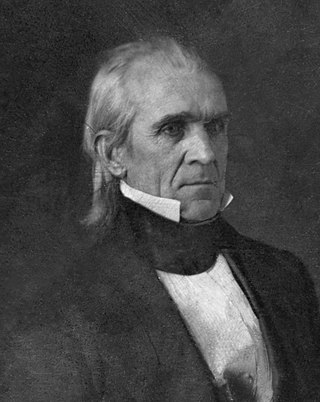
The 1844 United States presidential election was the 15th quadrennial presidential election, held from Friday, November 1 to Wednesday, December 4, 1844. Democrat James K. Polk narrowly defeated Whig Henry Clay in a close contest turning on the controversial issues of slavery and the annexation of the Republic of Texas. This is the only election in which both major party nominees served as Speaker of the House at one point, and the first in which neither candidate held elective office at the time.

The Compromise of 1850 was a package of five separate bills passed by the United States Congress in September 1850 that temporarily defused tensions between slave and free states in the years leading up to the American Civil War. Designed by Whig senator Henry Clay and Democratic senator Stephen A. Douglas, with the support of President Millard Fillmore, the compromise centered on how to handle slavery in recently acquired territories from the Mexican–American War (1846–48).
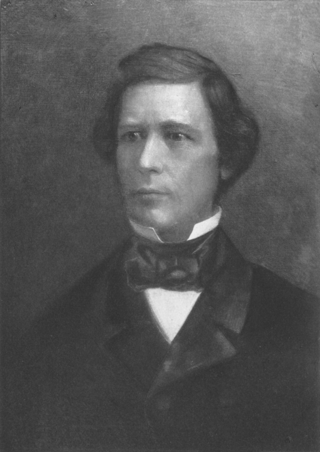
The Wilmot Proviso was an unsuccessful 1846 proposal in the United States Congress to ban slavery in territory acquired from Mexico in the Mexican–American War. The conflict over the Wilmot Proviso was one of the major events leading to the American Civil War.
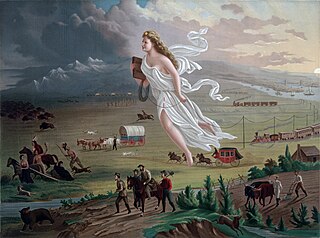
Manifest destiny was a phrase in the 19th-century United States that represented the belief that American settlers were destined to expand westward across North America, and that this belief was both obvious ("manifest") and certain ("destiny"). The belief was rooted in American exceptionalism and Romantic nationalism, implying the inevitable spread of the Republican form of governance. It was one of the earliest expressions of American imperialism in the United States of America.

The Treaty of Guadalupe Hidalgo officially ended the Mexican–American War (1846–1848). It was signed on 2 February 1848 in the town of Guadalupe Hidalgo.

Thomas Hart Benton, nicknamed "Old Bullion", was an American politician, attorney, soldier, and longtime United States Senator from Missouri. A member of the Democratic Party, he was an architect and champion of westward expansion by the United States, a cause that became known as Manifest Destiny. Benton served in the Senate from 1821 to 1851, becoming the first member of that body to serve five terms.
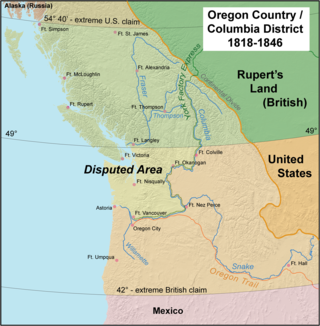
The Oregon Treaty is a treaty between the United Kingdom and the United States that was signed on June 15, 1846, in Washington, D.C. The treaty brought an end to the Oregon boundary dispute by settling competing American and British claims to the Oregon Country; the area had been jointly occupied by both Britain and the U.S. since the Treaty of 1818.

The Republic of Texas was annexed into the United States and admitted to the Union as the 28th state on December 29, 1845.

The Mexican Cession is the region in the modern-day western United States that Mexico previously controlled, then ceded to the United States in the Treaty of Guadalupe Hidalgo in 1848 after the Mexican–American War. This region had not been part of the areas east of the Rio Grande that had been claimed by the Republic of Texas, though the Texas annexation resolution two years earlier had not specified the southern and western boundary of the new state of Texas. At roughly 529,000 square miles (1,370,000 km2), not including any Texas lands, the Mexican Cession was the third-largest acquisition of territory in U.S. history, surpassed only by the 827,000-square-mile (2,140,000 km2) Louisiana Purchase and the 586,000-square-mile (1,520,000 km2) Alaska Purchase.

The Oregon boundary dispute or the Oregon Question was a 19th-century territorial dispute over the political division of the Pacific Northwest of North America between several nations that had competing territorial and commercial aspirations in the region.

The Ostend Manifesto, also known as the Ostend Circular, was a document written in 1854 that described the rationale for the United States to purchase Cuba from Spain while implying that the U.S. should declare war if Spain refused. Cuba's annexation had long been a goal of U.S. slaveholding expansionists. At the national level, American leaders had been satisfied to have the island remain in weak Spanish hands so long as it did not pass to a stronger power such as Britain or France. The Ostend Manifesto proposed a shift in foreign policy, justifying the use of force to seize Cuba in the name of national security. It resulted from debates over slavery in the United States, manifest destiny, and the Monroe Doctrine, as slaveholders sought new territory for the expansion of slavery.

Robert James Walker was an American lawyer, economist and politician. An active member of the Democratic Party, he served as a member of the U.S. Senate from Mississippi from 1835 until 1845, as Secretary of the Treasury from 1845 to 1849 during the administration of President James K. Polk, and briefly as Territorial Governor of Kansas in 1857. He was responsible for drafting the 1849 bill that eventually established the United States Department of the Interior.
A filibuster, also known as a freebooter, is someone who engages in an unauthorized military expedition into a foreign country or territory to foster or support a political revolution or secession. The term is usually applied to United States citizens who incited insurrections across Latin America, particularly in the mid-19th century, usually with the goal of establishing an American-loyal regime that could later be annexed into the United States. Probably the most notable example is the Filibuster War initiated by William Walker in Nicaragua in the 1850s.

Carlos Antonio Carrillo was a Californio politician, military officer, and ranchero. He was nominated to serve as Governor of Alta California from 1837–38, in opposition to Juan Bautista Alvarado's rule. However, after failing to subdue Alvarado, Carrillo relinquished his claim to the governorship to Alvarado in 1838.

The presidency of James K. Polk began on March 4, 1845, when James K. Polk was inaugurated as President of the United States, and ended on March 4, 1849. He was a Democrat, and assumed office after defeating Whig Henry Clay in the 1844 presidential election. Polk left office after one term, fulfilling a campaign pledge he made in 1844, and he was succeeded by Whig Zachary Taylor. A close ally of Andrew Jackson, Polk's presidency reflected his adherence to the ideals of Jacksonian democracy and manifest destiny.

The Mexican–American War, also known in the United States as the Mexican War, and in Mexico as the United States intervention in Mexico, was an invasion of Mexico by the United States Army from 1846 to 1848. It followed the 1845 American annexation of Texas, which Mexico still considered its territory because Mexico refused to recognize the Treaties of Velasco, signed by President Antonio López de Santa Anna after he was captured by the Texian Army during the 1836 Texas Revolution. The Republic of Texas was de facto an independent country, but most of its Anglo-American citizens who had moved from the United States to Texas after 1822 wanted to be annexed by the United States.

The 1844 Democratic National Convention was a presidential nominating convention held in Baltimore, Maryland from May 27 through 30. The convention nominated former Governor James K. Polk of Tennessee for president and former Senator George M. Dallas of Pennsylvania for vice president.

The history of U.S. foreign policy from 1829 to 1861 concerns the foreign policy of the United States during the presidential administrations of Andrew Jackson, Martin Van Buren, William Henry Harrison, John Tyler, James K. Polk, Zachary Taylor, Millard Fillmore, Franklin Pierce, and James Buchanan. During this era, the United States annexed the Republic of Texas, acquired the Mexican Cession by defeating Mexico in the Mexican–American War and partitioned Oregon Country with the United Kingdom of Great Britain and Ireland. The period began with the inauguration of Jackson in 1829, while the onset of the American Civil War in 1861 marked the start of the next period in U.S. foreign policy.
